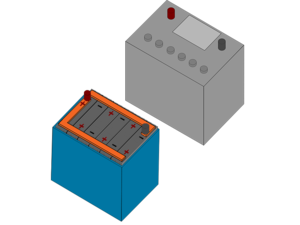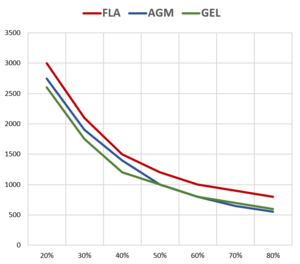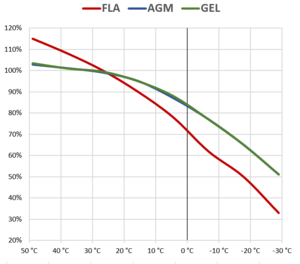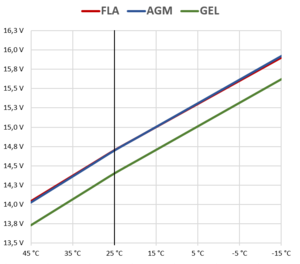Lead acid battery
Lead acid batteries rely on reversible chemical reactions between lead and acid to provide energy when it is needed and to store energy when it is being produced. They have been around for over 150 years and have proven their durability, low-cost, recyclability, and performance under variable conditions to the point that nearly every automobile on the planet relies on a lead acid battery to start and run. Lead acid batteries have been the preferred form of energy storage for off-grid PV systems since they first began being built for the same reasons, thus most off-grid PV components are built for use with lead acid batteries in 12 V, 24 V or 48 V configurations. Lead acid batteries have the added advantage of coming in a variety of voltages (2 V, 6 V, 12 V) and amp-hour ratings (5 Ah to 5000+ Ah). But due to their high density of lead, these batteries are extremely heavy. A 12 V, 225 Ah flooded lead acid battery weighs around 60 kg, which is approaching the upper-limit of what is easily movable without equipment.
Just like how a PV module is comprised of various different PV cells connected together in series that each produce a certain voltage, lead acid batteries are composed of series connected cells with each one producing around being having a nominal voltage of roughly 2 V. This means that a 12 V battery will consist of 6 cells.
There are many different types of lead acid batteries, but they can initially be divided into two categories: starter batteries and deep-cycle batteries.
- Starter batteries are used in cars and are intended to provide large amounts of power for short periods of time with a shallow depth of discharge. They work well for this purpose, but they are unable to continuously supply power beyond a shallow depth of discharge without severely shortening their cycle life. These batteries will fail prematurely in a PV system and are not worth investing in.
- Deep-cycle batteries have a more robust design that enables them to continuously supply high amounts of power to a deeper depth of discharge - generally considered to be around 80%. These batteries are heavier and cost more than starter batteries but are the appropriate battery for use with a PV system.
This page will focus on flooded lead acid (FLA) and valve regulated lead acid (VRLA) deep-cycle batteries.
Contents
Flooded lead acid (FLA)
The original lead acid battery design. They are the simplest, most durable and cheapest of the lead acid batteries. They are slightly more durable as they tend to be more forgiving of deep discharges than maintenance-free VRLA batteries.
Characteristics:
- They require monthly maintenance as the batteries will lose water as they charge and discharge. Durable, long cycle life and cheap only if properly maintained. If maintenance is not performed regularly, the batteries will rapidly fail, and replacement will cost significantly if maintenance-free batteries had been used initially.
- Release significant amounts of hydrogen gas.
- Have a liquid electrolyte solution inside that requires that they remain upright.
- Can undergo an equalization charge which can help to prolong their cycle life.
Considerations for use:
- End users that are capable of maintaining a battery (with proper training and protective equipment) or in a location where the system can be serviced by technicians.
- Users must have reliable access to distilled water was any other form of water has impurities and will damage the battery.
- Require a secure space with proper ventilation due to the combined hazard of the batteries spilling acid and their tendency to release significant amounts of hydrogen gas.
- May not be the best battery type with either extreme high or low temperatures.
- Low budget and high energy needs.
Valve-regulated lead acid (VRLA)
In the 1970's maintenance-free lead acid batteries began to enter the market. These batteries are designed to address several of the primary concerns that arise with FLA batteries. They are less durable, have a shorter cycle life and cost significantly more than flooded lead acid batteries. They are less forgiving of deep discharges. There are two primary sub-categories of VRLA batteries: AGM and Gel.
Characteristics:
- They do not require maintenance.
- They are sealed (although not completely) so there is little to no offgassing.
- They do not have a liquid electrolyte solution inside and are additionally sealed to prevent leaks, therefore they do not have to be positioned upright at all times.
Considerations for use:
- End users that may not perform maintenance.
- Locations in which there is not a separate space that can be dedicated to energy storage.
- Require a higher budget.
Absorption glass mat (AGM)
A VRLA battery in which the electrolyte solution is contained within mats of fine glass fibers. These batteries cost on average 1.5-2 times as much as FLA and have a shorter cycle life when compared to a properly maintained FLA battery.
Specific considerations for use:
- Perform better than FLA and gel batteries in cold environments. FLA batteries can freeze and be damaged during charging/discharging.
Gel
A VRLA battery in which the electrolyte solution is made into a gel paste. Gel batteries are the costliest lead acid option. They prefer slow charging and discharging, which is not ideal for renewable energy systems.
Specific considerations for use:
- Perform better than AGM and FLA batteries in hot environments.
Storage capacity
The storage capacity of a lead acid battery is measured in amp-hours (Ah). The amount of this energy that is actually usable energy upon:
- The rate at which energy is withdrawn. If a battery lead acid battery is discharged rapidly, the amount of usable energy decreases. Conversely, if discharged slowly, the usable energy increases. This is measured in in terms of C-rate. A C-rate of 1 means that the entire capacity of the battery is discharged in 1 hour. A C-rate of 20 or C/20 means that the entire capacity of the battery is discharged over the course of 20 hours. Lead acid batteries are typically rated by their C/20 rate. Below is an example for a Trojan 12 V 205 Ah AGM battery:[1]
C-rate Amp-hours 10 hour 174Ah 20 hour 205Ah 48 hour 210Ah 72 hours 213Ah 100 hours 216Ah
- The chosen depth of discharge limit for a battery. The cycle life of a battery depends greatly upon how deeply it is discharged and how frequently. The numbers of cycles vary depending upon the type of battery as well.
- The temperature of the battery. The temperature of the battery will affect the usable energy of a battery. Hotter temperatures increase the usable capacity of a battery, but greatly shorten the cycle life of the battery. For lead acid batteries it is estimated that for every 10°C increase in average temperature above 25°C shortens the batteries life by half. This means that operating a lead acid battery for one month at 35°C is equivalent in terms of battery life to operating the battery for two months at 25°C.[1]
Temperature
The temperature of a lead acid battery or battery cell directly influences its resting voltage and the voltages at which it should be charged. Ambient temperature is a major factor, but batteries also internally generate heat as they charge and discharge. For lead acid batteries it is estimated that for every 10°C increase in average temperature above 25°C shortens the batteries life by half. This means that operating a lead acid battery for one month at 35°C is equivalent in terms of battery life to operating the battery for two months at 25°C[1]. The design of battery storage as well as choosing a proper charging method that takes into account temperature is vital to ensuring that a system performs properly.
Efficiency
There is no type of storage that is perfectly efficient. Lead acid batteries inherently lose some energy as it is put into the battery and some as it is withdrawn, generally as heat. A FLA battery is typically only 80-85% efficient, whereas a VRLA battery is has a slightly higher efficiency of 85-90% efficiency. This is round -trip efficiency, meaning that if 100Wh of energy arrives from a PV module arrives that the terminals of a FLA battery and a VRLA battery:
- 80-85 Wh will be able to be withdrawn from the FLA battery.
- 85-90 Wh will be able to be withdrawn from the VRLA battery.
Charging
Lead acid batteries have specific charging requirements that must be followed to ensure that they continue functioning for a their rated cycle life. For more information on the the different charging phases - see Charging phases.
Sulfation
It is important that batteries reach a full state of charge (90-100%) on a regular basis. If batteries do not reach a full state of charge every few days, then the plates within the battery will begin a process of sulfation which is the buildup of sulfate crystals on the plates of the battery that will start to impede performance and can ultimately lead the battery to cease functioning. Although a 30% depth of discharge is rather shallow for off-grid systems, if a battery regularly sits at 70% state of charge (the inverse of a 30% DoD) the batteries will begin to sulfate, lose performance and fail prematurely.
It is necessary to build a system with a PV charging source that can supply sufficient current to bring the batteries up to charge regularly while loads continue to operate. With FLA batteries it is possible to do a monthly equalization charge to reverse some of the sulfation, but this is not possible with VRLA batteries.
Charge rate
If an off-grid PV system will rely solely upon PV as a charging source (no generator, no other renewables) then it is necessary to ensure that a PV source is properly sized for this role. The PV source size should be checked to ensure that it can supply sufficient current to properly charge the energy storage system. If lead acid batteries do not regularly receive an adequate charging current - typically because the PV source is undersized relative to the energy storage system - they will begin to experience sulfation and they will last for fewer cycles.
Lead acid batteries last longer and perform better when they are regularly recharged with a current in a certain range - typically between 5-13% of their C/20 rating.[5][6] It is best practice to consult the manual or manufacturer for recommended maximum and minimum charging currents. If a system uses many loads during the day, this will limit the available charging current for the energy storage system and should be taken into account.
- A minimum of 5% of the C/20 Ah rating is recommended for a system that is used infrequently or is primarily used at night.[5][6]
- A 10% of the C/20 Ah rating is recommended for a system that is used regularly with significant load usage during the day.
- A maximum of 13% of the C/20 Ah rating is recommended.[5]
Battery storage
Due to safety issues posed by batteries (high available current, hazardous gases, dangerous chemicals) it is always necessary to put batteries in a secure room or enclosure to avoid unauthorized access to them. For small-scale off-grid systems they are typically housed in a battery box that is constructed to the required size of the battery bank. The most common and easy to work with material in most areas is wood, but it is also possible to build a suitable enclosure out of metal. Batteries should be checked regularly and serviced as needed, therefore it is important that any type of enclosure that they are placed into provides sufficient working space.
Location and security
Batteries must be placed in a location that will provide both adequate cooling and safe storage. If a battery box is to be placed in an accessible location, then it is necessary that it has a means to avoid unauthorized access, like a lock. If the batteries are in a room without a battery box, it is necessary that the room itself be locked to avoid unauthorized access. A battery box should not be become means for storage - adequate space should always be left so that the lid can easily be opened without the need to move other items. Many batteries come with a rubber cover for the terminals, this can be a useful safety measure to prevent accidental short-circuits from accidents like tools being dropped across the terminals.
Ventilation
As batteries, especially FLA batteries, produce potentially explosive hydrogen, it is recommended that they are stored in a location with adequate free airflow. This is additionally important for cooling. If batteries are to be placed in a battery box, then holes should be made near the lid to enable rising hydrogen to escape.
Spacing between batteries
Adequate spacing is important to permit adequate cooling of batteries and to permit safe working conditions. In cool climates - maximum temperature indoors under 30°C - a battery bank should allow for:
- At least 2.5 cm should be left between batteries.
- At least 15 cm of perimeter around the batteries. This may be 15cm between the batteries and the sides of the battery box or 15cm between the batteries and the nearest object if they are not in a box.
In warmer climates more spacing can be provided and additional considerations should be taken for battery cooling. In even cooler climates, insulating the battery box may be an appropriate choice to improve performance and prevent freezing.
Spill containment with FLA batteries
As FLA batteries contain an acidic electrolyte in liquid form, it is common for them to overflow during maintenance or if they are over-charged. It is important to build a spill containment system that can handle the amount of electrolyte that a battery bank could potentially spill. Placing the batteries in a plastic or rubber tray with a tip of at least 2" is recommended.
Dating batteries
It is important to understand the age of batteries when purchasing them and when servicing them. Batteries use a unique dating system. The month of production corresponds to a letter - beginning with "A" for December. The letter "I" is skipped due to its similarity to the number "1." The year of production corresponds to a number with "0" being the first year of a decade. For example a batter produced in March of 2018 would have a date code of "C8."
Safety
Lead acid batteries contain lead and acid, both of which are hazardous if they contact the skin or are ingested. Flooded lead acid battery banks require regular service, which means coming into direct contact with the acid inside of a battery. Proper personal protective equipment (PPE) should be worn at all times, with gloves and goggles being the bare minimum. Hands should be washed immediately after working with batteries to remove any lead or acid that may have been accidentally contacted. For more information on electrical safety when working with batteries see: Electrical safety with batteries.
Recyclability
Lead acid batteries contain lead and acid, both of which are hazardous materials that must be disposed of properly[7]. Lead acid batteries are often pointed to as a success story for recycling as the majority of lead is used for batteries and an estimated 95-96% is ultimately recycled[8]. This largely has to do with a well-developed market, supply chain and abundant processing facilities for lead acid batteries as lead is a valuable material and is readily recyclable. This knowledge has spread and has resulted in batteries being returned for cash in even the most remote places.
Notes
- ↑ 1.0 1.1 1.2 Trojan Battery Company - Specifications sheet for 12 V 205 Ah AGM battery https://www.trojanbattery.com/pdf/SAGM_12_205_AGM_DS.pdf
- ↑ 2.0 2.1 2.2 Trojan Battery Company - Specifications sheet for FLA batteries https://www.trojanbattery.com/pdf/Signature_Trojan_ProductLineSheet.pdf
- ↑ 3.0 3.1 3.2 Trojan Battery Company - Specifications sheet for AGM batteries https://www.trojanbattery.com/pdf/AGM_Trojan_ProductLineSheet.pdf
- ↑ 4.0 4.1 4.2 Trojan Battery Company - Specifications sheet for Gel batteries https://www.trojanbattery.com/pdf/GEL_Trojan_ProductLineSheet.pdf
- ↑ 5.0 5.1 5.2 Trojan Battery Company - User's Guide https://www.trojanbattery.com/pdf/TrojanBattery_UsersGuide.pdf
- ↑ 6.0 6.1 The maximum charging current for most lead acid batteries is around 13% of the C/20 rate. Rolls Battery - Battery User Manual https://rollsbattery.com/public/docs/user_manual/Rolls_Battery_Manual.pdf
- ↑ GIZ report on End-of-Life Management of Batteries in the Off-Grid Solar Sector https://www.giz.de/de/downloads/giz2018-en-waste-solar-guide.pdf
- ↑ United Nations Enviromental Program report on recycling metals https://wedocs.unep.org/bitstream/handle/20.500.11822/8702/Recycling_Metals.pdf?sequence=1&isAllowed=y






